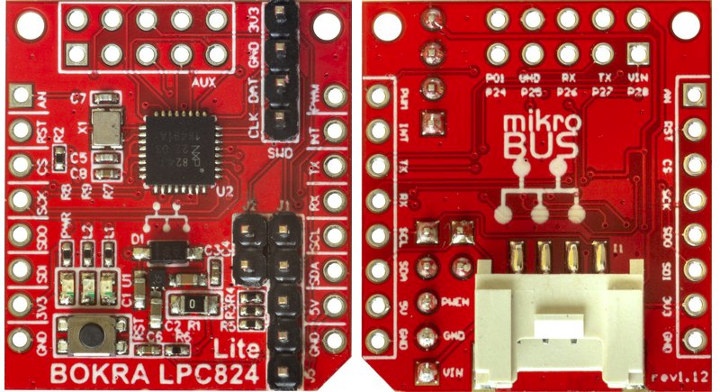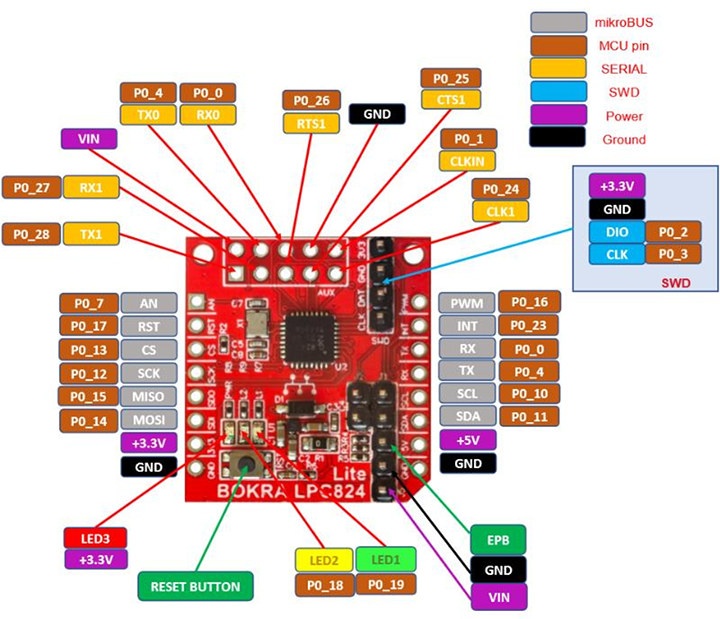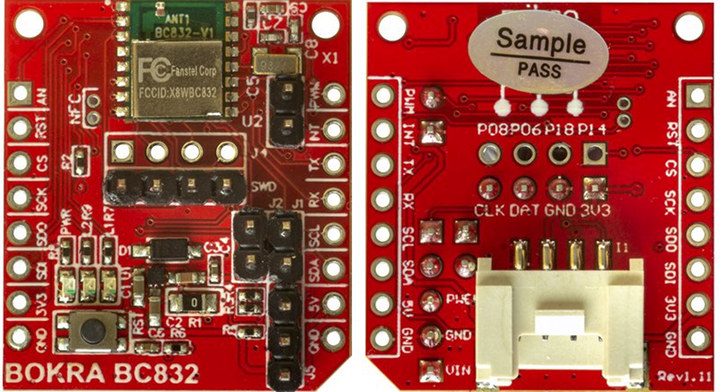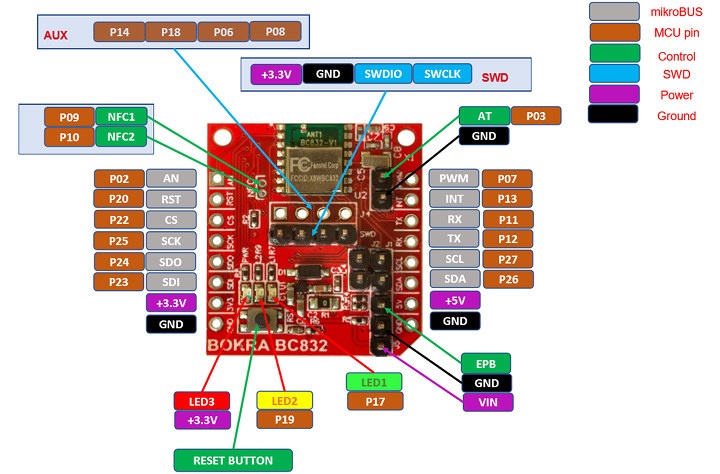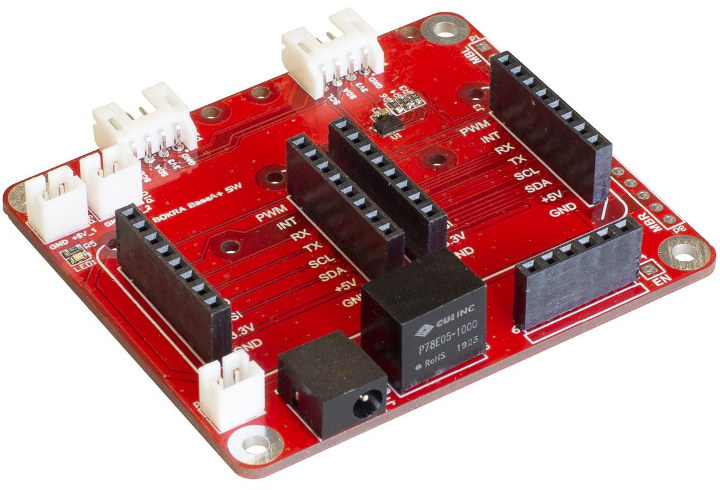We first wrote about MikroElectronika MikroBUS socket in 2015 while covering an SBC which featured one MikroBUS socket supporting one of the 150 Click boards available at the time.
There are now over 700 Click boards to choose from, with the tiny modules offering motor drivers, buttons, short-range connectivity, UART and other interfaces, as well as various sensors. But BOKRA had another idea: developing MCU based systems-on-module following MikroBUS form factor.
BOKRA LPC824 Lite module
The first of those modules is BOKRA LPC824 Lite with the following specifications:
- MCU – NXP LPC824M201JHI33 Arm Cortex-M0+ microcontroller @ 30 MHz with 32KB Flash Memory, 8 KB RAM
- I/O
- MikroBUS headers with SPI, I2C, UART, PWM, GPIOs
- 10-pin “Serial” header
- 4-pin I2C Grove connector for Seeed Studio I2C Grove modules
- Debugging interface – SWD
- Misc – Reset button, power LED, 2x user LEDs
- Power Supply – 5V/500mA via MIC5528 regulator
- Dimensions – 28.6 x 25.4 mm (MikroBUS size “S” form factor)
BOKRA LPC824 Lite is compatible with the free LPCXpresso IDE (v8.2.2 or higher), Keil MDK and other IDEs.
The board could be integrated into projects using sensors, (simple) motor control, industrial applications, portable and wearable devices, game controllers, lighting, consumer devices, fire and security applications, and climate control.
BOKRA BC832 module
If you’d rather have a board with a more powerful microcontroller with built-in wireless connectivity, BOKRA BC832 MikroBUS SoM provides Bluetooth 5.0 Low Energy via Nordic Semi nRF52832 WiSoC.
Specifications:
- SiP (System-in-Package) – Fanstel BC832 module with Nordic Semi nRF52832 CIAA Cortex-M4 MCU @ 64 MHz, 512 KB flash, 64KB RAM
- Connectivity – Bluetooth 5.0 LE, 2.4GHz proprietary, NFC Tag-A
- I/O
- MikroBUS headers with SPI, I2C, UART, PWM, GPIOs
- 4-pin AUX header with 4x GPIOs, 2-pin header with GPIO/AT and GND
- 4-pin I2C Grove connector for Seeed Studio I2C Grove modules
- Debugging interface – SWD
- Misc – Reset button, power LED, 2x user LEDs
- Power Supply – 5V/500mA via MIC5528 regulator
- Dimensions – 28.6 x 25.4 mm (MikroBUS size “S” form factor)
BOKRA did not provide any details about software development, but the board is likely supported by the usual nRF52 tools such as SEGGER Embedded Studio, Keil, GCC, and IAR IDEs and toolchains.
Some of the applications for the board include IoT (Internet of Things), building and home automation, lighting products, sensors, portable devices, fitness/sports trackers, and “interactive entertainment devices”.
BOKRA BaseA+ 5W MikroBUS Baseboard
I’d assume a BOKRA MCU module could be inserted into any board with a MikroBUS socket, for example, to handle some real-time tasks, as long as it can deliver the 2.5W needed for the board.
Alternatively, the company made its own MikroBUS baseboard with two sockets and the following specifications:
- 2x mikroBUS socket for “S” or “M” modules with a shared bus
- Connectivity – 6-pin header for optional ESP-M3 ESP8266 WiFi module
- Expansion – Unpopulated MBR and MBL headers routing MikroBUS signal to the side of the board
- Sensor – LM75B I2C temperature sensor with 2 to 3°C accuracy, -55°C to 125°C range
- Power Supply
- 9VDC to 36VDC input via power barrel jack
- 5V/1A output
- Dimensions – 65 x 56 mm compatible with Raspberry Pi 3A+
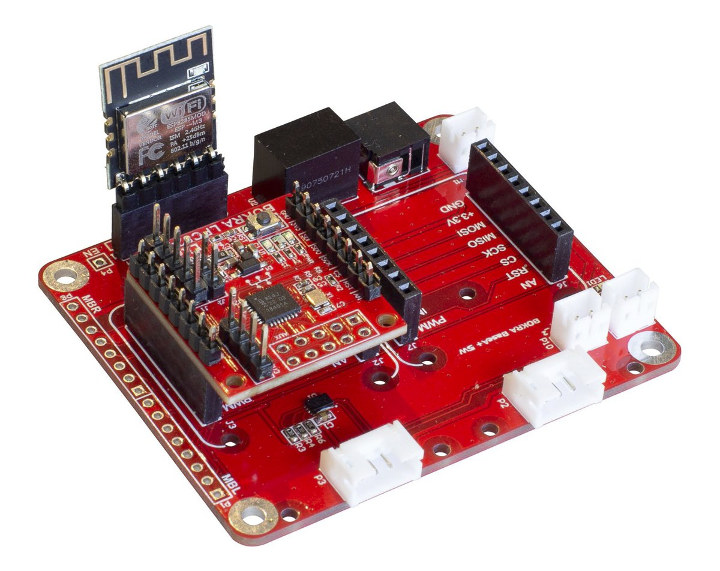
Availability and Pricing
All three boards are available now on Tindie with BOKRA LPC824 Lite going for $16, BOKRA BC832 for $28, and BaseA+ 5W baseboard for $20.

Jean-Luc started CNX Software in 2010 as a part-time endeavor, before quitting his job as a software engineering manager, and starting to write daily news, and reviews full time later in 2011.
Support CNX Software! Donate via cryptocurrencies, become a Patron on Patreon, or purchase goods on Amazon or Aliexpress


